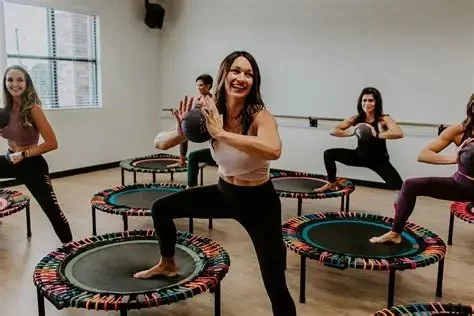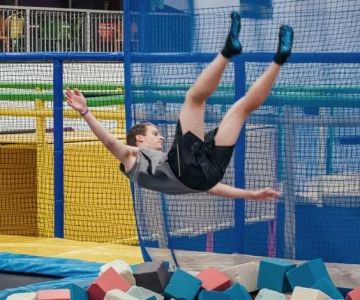
- why-trampoline-training-boosts-balance-and-coordination
- key-trampoline-moves-for-improving-body-control
- real-world-results-and-personal-testimonials
- how-trampoline-fitness-compares-to-other-balance-methods
- expert-tips-to-maximize-progress-safely
- explore-trampoline-zone-for-balance-building-tools
1. Why Trampoline Training Boosts Balance and Coordination
When most people think of trampolines, they picture fun. But for athletes, physical therapists, and fitness enthusiasts, trampolines are a secret weapon for developing balance, body awareness, and precise coordination. The micro-adjustments your body makes with every bounce challenge both your muscular and nervous systems in ways traditional workouts can't match. That’s what makes trampoline exercises that improve balance and coordination so effective—and enjoyable.
Unlike a static floor, a trampoline's surface is dynamic. Your brain and muscles must communicate constantly to stay upright and adjust your posture. This reactive training stimulates proprioceptors—sensory receptors in muscles and joints—leading to better control, agility, and reflexes.
2. Key Trampoline Moves for Improving Body Control
Not all trampoline exercises are created equal. If your goal is to enhance stability and coordination, it’s important to choose movements that challenge your entire kinetic chain.
2.1 Single-Leg Bounces
This deceptively simple move trains ankle stability, core control, and balance. Begin with short durations and switch legs. As your control improves, add arm swings or close your eyes for an extra challenge.
2.2 Tuck Jumps with Pause
Jump into a tucked position (knees to chest), but instead of bouncing immediately after landing, pause and stabilize before your next jump. This helps train deceleration control, essential for real-world balance like climbing stairs or avoiding falls.
2.3 Lateral Bounds
Shifting side to side across the trampoline engages your obliques, hips, and glutes—muscle groups essential for side-to-side control. This is especially helpful for sports like tennis or basketball that require lateral quickness.
2.4 Arm-Reach Stability Drills
While holding a stable core, use your arms to reach forward, sideways, or overhead as you gently bounce. This challenges your body’s ability to manage shifting weight and stay centered under moving loads.
3. Real-World Results and Personal Testimonials
Julie, a 38-year-old physical therapist in Austin, started using trampoline-based therapy for her post-ACL surgery rehab. “It was more fun than standing on wobble boards, and I could feel my ankle and core working overtime,” she recalls. Within six weeks, her coordination and balance returned faster than expected—and she kept the workouts in her weekly routine.
Meanwhile, Marcus, a high school basketball player in Chicago, used trampoline drills to improve mid-air control and landings. His coach noticed he was more stable on rebounds and less prone to awkward falls after layups. “I didn’t just jump higher—I landed smarter,” Marcus shared in an interview for a local sports blog.
4. How Trampoline Fitness Compares to Other Balance Methods
Balance training isn’t new—yoga, BOSU balls, and tai chi have long offered effective ways to improve body control. But trampolining introduces movement, rhythm, and unpredictability that mimic real-life motion more closely than static poses.
4.1 Enhanced Sensory Feedback
Unlike a floor mat, the soft, reactive surface of a trampoline magnifies every misalignment, helping the user become more aware of body positioning and movement efficiency.
4.2 Cardiovascular and Neuromuscular Benefits
Balance boards work muscles, but rarely raise your heart rate. Trampolines offer the best of both—neuromuscular training plus cardio, making your workouts more efficient.
4.3 Accessibility Across Ages
From kids to older adults, trampoline fitness can be scaled in intensity. Low-impact bouncing is gentler on joints than pavement running or plyometrics, which makes it ideal for long-term coordination training.
5. Expert Tips to Maximize Progress Safely
To get the most from trampoline workouts, follow a progression strategy. Start with short sessions (10–15 minutes), focusing on form and control rather than height or tricks. Wear grip socks or go barefoot to increase sensory input, and always warm up before bouncing.
If you’re recovering from an injury or have balance issues, consult a trainer or physical therapist who can personalize your trampoline routine and monitor your form. Consistency matters more than intensity—just a few sessions per week can yield noticeable improvements within a month.
6. Explore Trampoline Zone for Balance-Building Tools
If you're ready to explore the potential of trampoline exercises that improve balance and coordination, Trampoline Zone offers everything from beginner-friendly rebounders to pro-grade gear. Their team understands the biomechanics of balance training and can help match you with equipment suited to your goals and skill level.
Whether you're an athlete fine-tuning movement skills, a parent looking for safe, fun activity options, or simply someone wanting to move better in everyday life—Trampoline Zone is the place to begin your journey toward better coordination and body control.







 Jump Town USA4.0 (221 reviews)
Jump Town USA4.0 (221 reviews) Jump! City4.0 (36 reviews)
Jump! City4.0 (36 reviews) Altius Gymnastics Academy4.0 (66 reviews)
Altius Gymnastics Academy4.0 (66 reviews) Bounce House4.0 (483 reviews)
Bounce House4.0 (483 reviews) Jefferson School Park4.0 (109 reviews)
Jefferson School Park4.0 (109 reviews) Urban Air Trampoline and Adventure Park3.0 (148 reviews)
Urban Air Trampoline and Adventure Park3.0 (148 reviews) Are Trampoline Parks Safe for Kids? Essential Guide for U.S. Parents
Are Trampoline Parks Safe for Kids? Essential Guide for U.S. Parents How Often Should You Replace Trampoline Springs? Tips for Proper Maintenance
How Often Should You Replace Trampoline Springs? Tips for Proper Maintenance How Much Is a Trampoline? A Detailed Guide to Trampoline Costs and Buying Tips
How Much Is a Trampoline? A Detailed Guide to Trampoline Costs and Buying Tips Bounce Techniques for Stronger Legs: Effective Exercises and Tips
Bounce Techniques for Stronger Legs: Effective Exercises and Tips Essential Music Gear for Trampoline Dance: Complete Guide
Essential Music Gear for Trampoline Dance: Complete Guide Fun STEM Experiments Using Trampolines to Spark Curiosity and Learning
Fun STEM Experiments Using Trampolines to Spark Curiosity and Learning